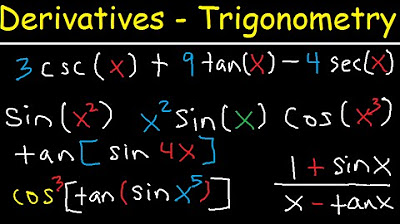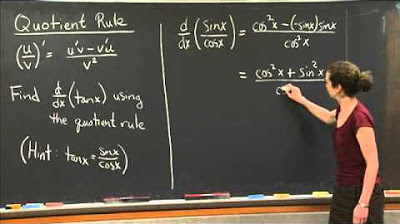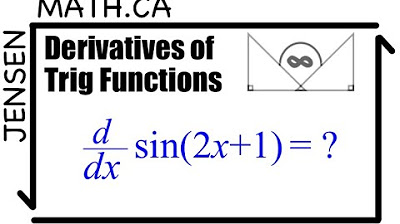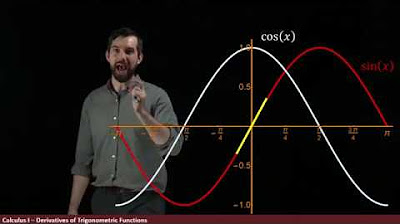Derivatives of Trigonometric Functions
TLDRThis video explains how to take the derivatives of trigonometric functions like sine, cosine, tangent, and their inverses. It starts by visually showing how to find the derivative of sine from its graph, realizing it is cosine. Similarly for cosine, its derivative is negative sine. Using rules like the quotient rule, the derivatives of tangent, cotangent, secant, and cosecant are derived as well. Some examples are then shown applying these rules with the product and quotient rules. Finally, the derivatives of the six inverse trig functions are simply stated to memorize before the video concludes.
Takeaways
- 😀 The derivatives of the 6 trig functions are: sin(x) = cos(x), cos(x) = -sin(x), tan(x) = sec^2(x), cot(x) = -csc^2(x), sec(x) = sec(x)tan(x), csc(x) = -csc(x)cot(x)
- 😎 To find derivatives of trig functions, analyze slopes at key points and relate to basic trig function graphs
- 📈 Use product rule, quotient rule and pythagorean identities to find derivatives of more complex trig expressions
- 🎯 The derivatives of inverse trig functions have 1/sqrt(x^2 ± a^2) type formats
- 🤓 Memorize derivatives of 6 trig functions & rules to tackle trig differentiation problems
- 😊 Maxima/minima on sin(x)/cos(x) graphs = horizontal tangents = 0 derivative
- 🔍 Increasing/decreasing sections on sin(x)/cos(x) match positive/negative derivative signs
- 🧠 Derivative of tan(x) involves quotient rule, pythagorean identity and cosecant definition
- 📒 Example problems: derive (x^2)*sin(x) and x/cos(x)
- ❗Trig differentiation gets trickier, but mastering these basics will help tremendously
Q & A
What is the derivative of sine x equal to?
-The derivative of sine x is equal to cosine x.
How can you find the derivative of other trigonometric functions like tangent, using the derivatives of sine and cosine?
-You can use rules like the quotient rule. For example, to find the derivative of tangent x, you take cosine x times the derivative of sine x, minus sine x times the derivative of cosine x, over cosine squared x.
What is the derivative of secant x equal to?
-The derivative of secant x is equal to secant x times tangent x.
What is the significance of maxima, minima, and inflection points when thinking about derivatives of trigonometric functions?
-At maxima and minima, the tangent line is horizontal so the slope and derivative is 0. Inflection points mark the transition from increasing to decreasing slope.
What is the derivative of x squared times sine x?
-Using the product rule: (x squared)(cosine x) + (2x)(sine x)
What is the derivative of the quotient x over cosine x?
-Using the quotient rule: (cosine x) + (x sine x) over (cosine x) squared
What are some key derivatives to memorize?
-Memorize the derivatives of the 6 basic trig functions: sine x, cosine x, tangent x, cotangent x, secant x, and cosecant x. Also know the derivatives of their inverses.
How can the pythagorean identity help in simplifying some trig derivatives?
-The pythagorean identity states that sine squared x + cosine squared x = 1. This can help simplify expressions like the derivative of tangent x.
What rules are important for differentiating trig functions?
-Know how to apply rules like the product rule, quotient rule, and chain rule when differentiating expressions with trig functions.
What other types of functions have trickier derivatives?
-Exponential and logarithmic functions can have trickier derivatives. Also derivatives get more complex for partial derivatives and higher order derivatives.
Outlines
😀 Deriving Trig Function Derivatives
This paragraph introduces the topic of derivatives of trigonometric functions. It mentions taking derivatives of polynomials and special functions, then specifies the trig functions: sine, cosine, tangent, cosecant, secant, and cotangent. It refers back to a previous trigonometry video for clarity if needed, then proceeds with the assumption of understanding what these trig functions mean in order to learn how to take their derivatives.
😃 Using Graphs to Find Trig Derivative Patterns
This paragraph uses the graphical interpretation of derivatives as slopes of tangent lines to reason about and sketch the derivatives of sine and cosine. It identifies points where the derivatives are 0, ±1 and pieces together the full graphs, recognizing cosine as the derivative of sine, and -sine as the derivative of cosine. It then uses rules like the quotient rule to find the derivatives of the other trig functions like tangent, cotangent, cosecant, and secant.
Mindmap
Keywords
💡derivatives
💡trigonometric functions
💡slope
💡product rule
💡quotient rule
💡pythagorean identity
💡inverse trig functions
💡periodic function
💡maxima and minima
💡memorize
Highlights
The derivative of sine x is cosine x.
The derivative of cosine x is negative sine x.
The derivative of tangent x is secant squared x.
The derivative of cotangent x is negative cosecant squared x.
The derivative of cosecant x is negative cosecant cotangent x.
The derivative of secant x is secant tangent x.
Memorize the derivatives of the six trigonometric functions.
Use the product rule and quotient rule to differentiate functions with trigonometric terms.
The derivatives of the six inverse trigonometric functions are in the form of one over some expression involving x squared.
Example of differentiating (x^2)(sin x) using product rule.
Example of differentiating x/cos x using quotient rule.
The derivative turns sine x into cosine x.
The derivative turns cosine x into negative sine x.
Use rules already known to find derivatives of other trig functions from sine and cosine.
Check comprehension on finding derivatives of trig functions.
Transcripts
Browse More Related Video

Evaluating Integrals With Trigonometric Functions

Derivatives of Trigonometric Functions - Product Rule Quotient & Chain Rule - Calculus Tutorial

Quotient Rule | MIT 18.01SC Single Variable Calculus, Fall 2010

Derivatives of Trig Functions - Calculus | MCV4U

Derivatives of Trig Functions (Sin, Cos, Tan) in Calculus - [1-4]

The derivative of Trigonometric Functions
5.0 / 5 (0 votes)
Thanks for rating: